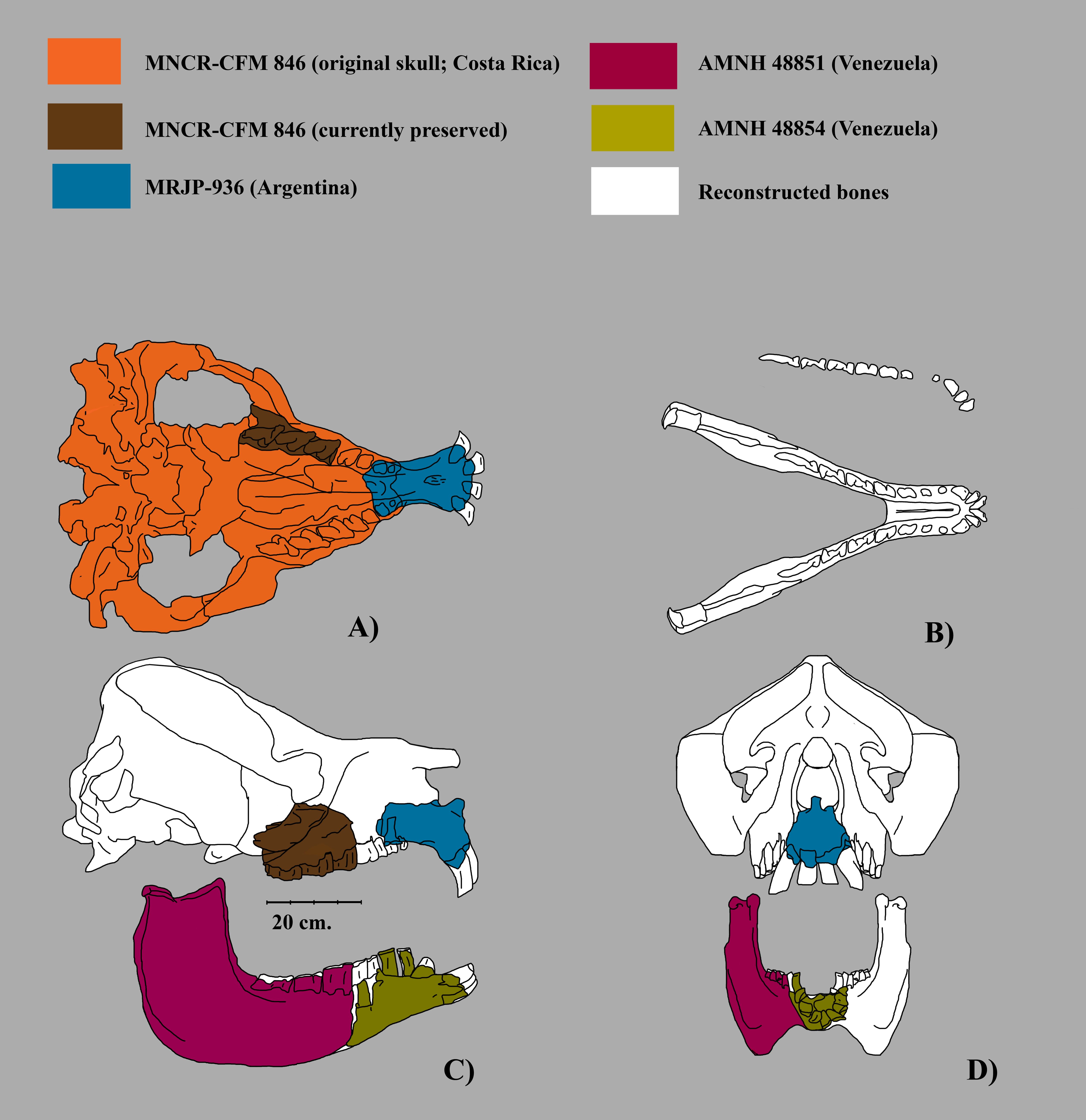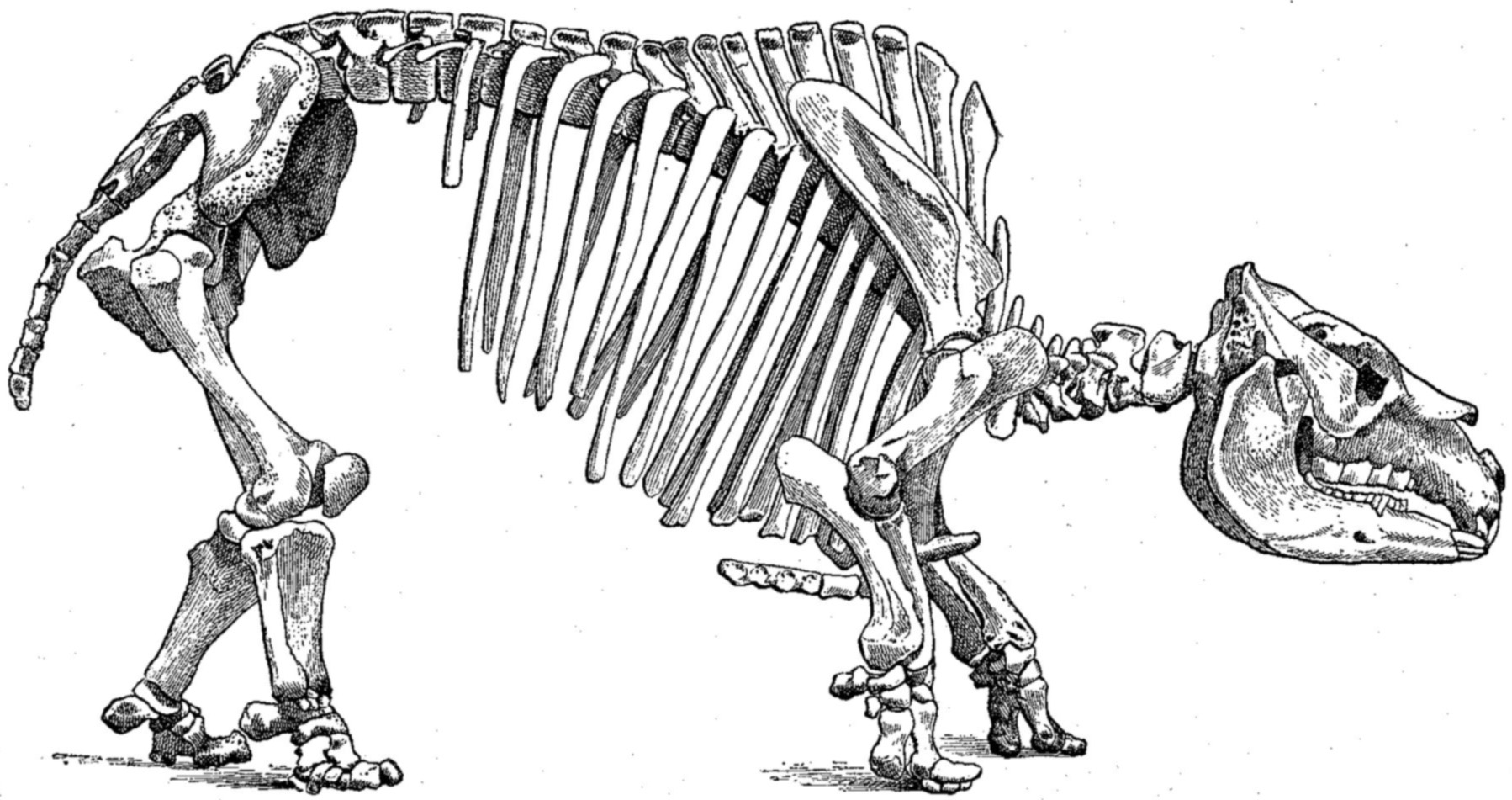|
Toxodont
Toxodontia. Retrieved April 2013. is a suborder of the meridiungulate order Notoungulata. Most of the members of the five included families, including the largest notoungulates, share several dental, auditory and tarsal specializations. The group is named after ''Toxodon'', the first example of the group to be discovered by science. Description Isotemnidae, the oldest and most primitive family of toxodonts, were generally large animals with larger canines than other early notoungulates. The family is probably paraphyletic or polyphyletic since only primitive dental features unite the 12 included genera, such as a complete dentition with unreduced canines and no diastemata in the earliest genera. Likewise, they are only weakly linked to other toxodonts by a few dental features, and their primitive cheek tooth pattern can be basal to all notoungulates except notioprogonians. The oldest of the 12 genera in this family is ''Isotemnus'' known from the Riochican-Casamayoran, bu ... [...More Info...] [...Related Items...] OR: [Wikipedia] [Google] [Baidu] |
Mixotoxodon
''Mixotoxodon'' ("mixture ''Toxodon''") is an extinct genus of notoungulate of the family Toxodontidae inhabiting South America, Central America and parts of southern North America during the Pleistocene epoch, from 1,800,000—12,000 years ago.''Mixotoxodon'' at .org Description 
[...More Info...] [...Related Items...] OR: [Wikipedia] [Google] [Baidu] |
Toxodontidae
Toxodontidae is an extinct family of notoungulate mammals, known from the Oligocene to the Holocene (11,000 BP) of South America, with one genus, ''Mixotoxodon'', also known from the Pleistocene of Central America and southwestern North America (Texas).E. Lundelius, et al. 2013. The first occurrence of a toxodont (Mammalia, Notoungulata) in the United States. ''Journal of Vertebrate Paleontology'', Vol 33, No 1, pp. 229–23DOI:10.1080/02724634.2012.711405/ref> They somewhat resembled rhinoceroses, and had teeth with high crowns and open roots, suggesting that they often fed on tough pampas grass. However, isotopic analyses have led to the conclusion that the most recent forms were grazing and browsing generalists. Taxonomy The endemic notoungulate and litoptern ungulates of South America have been shown by studies of collagen and mitochondrial DNA sequences to be a sister group to the perissodactyl Odd-toed ungulates, mammals which constitute the taxonomic order Perisso ... [...More Info...] [...Related Items...] OR: [Wikipedia] [Google] [Baidu] |
Toxodon
''Toxodon'' (meaning "bow tooth" in reference to the curvature of the teeth) is an extinct genus of South American mammals from the Late Miocene to early Holocene epochs (Mayoan to Lujanian in the SALMA classification) (about 11.6 million to 11,000 years ago). It is a member of Notoungulata, one of several now extinct orders of hoofed mammals indigenous to South America distinct from living perissodactyls and artiodactyls. It was among the largest and last members of its order, and was probably the most common large hoofed mammal in South America of its time. Taxonomy ''Toxodon'' was one of the last members of Notoungulata, a group of ungulates that had been part of the fauna of South America since the Paleocene. ''Toxodon'' was a member of Toxodontidae a large bodied group including similar, vaguely rhinoceros like forms. Charles Darwin was one of the first to collect ''Toxodon'' fossils, after paying 18 pence for a ''T. platensis'' skull from a farmer in Uruguay ... [...More Info...] [...Related Items...] OR: [Wikipedia] [Google] [Baidu] |
Martinmiguelia
''Martinmiguelia'' is an extinct genus of Notoungulate, belonging to the family Leontiniidae. It lived during the Middle Eocene, and its fossil remains were found in South America. Description This animal is only known from skull and mandible remains, and it probably shared similarities with later and better known leontiniids, such as ''Scarrittia''. It was smaller-sized than those derived genera, approximately the size of a sheep. ''Martinmiguelia'' was characterized by an archaic dental formula, with a complete dentition (three incisors, one canine, four premolars and three molars) and a quasi-absence of diastema, except for small spaces around the small-sized canines. The molars and premolars were low-crowned (brachydont), a primitive condition for leontinnids. The upper incisors were canine-like and possessed labial girdles, and the second upper incisor was larger than the others. Classification ''Martinmiguelia fernandezi'' was first described in 1995, based on fossils fou ... [...More Info...] [...Related Items...] OR: [Wikipedia] [Google] [Baidu] |
Notoungulata
Notoungulata is an extinct order of mammalian ungulates that inhabited South America from the early Paleocene to the Holocene, living from approximately 61 million to 11,000 years ago. Notoungulates were morphologically diverse, with forms resembling animals as disparate as rabbits and rhinoceroses. Notoungulata are the largest group of South American native ungulates, with over 150 genera in 14 families having been described, divided into two major subgroupings, Typotheria and Toxodontia. Notoungulates first diversified during the Eocene. Their diversity declined during the Late Neogene, with only the large toxodontids persisting until the end of the Pleistocene. Collagen analysis suggests that notoungulates are closely related to litopterns, another group of South American ungulates, and their closest living relatives being perissodactyls (odd-toed ungulates), including rhinoceroses, tapirs and equines. but their relationships to other South American ungulates are uncertain. Se ... [...More Info...] [...Related Items...] OR: [Wikipedia] [Google] [Baidu] |
Santacrucian
The Santacrucian age is a period of geologic time (17.5 – 16.3 Ma) within the Early Miocene epoch of the Neogene, used more specifically with SALMA classification in South America. It follows the Colhuehuapian and precedes the Friasian age. Etymology The age is named after the Santa Cruz Formation in the Austral/Magallanes Basin of southern Patagonia Patagonia () refers to a geographical region that encompasses the southern end of South America, governed by Argentina and Chile. The region comprises the southern section of the Andes Mountains with lakes, fjords, temperate rainforests, and gl ..., Argentina and Chile. Formations Fossils References Bibliography ;Santa Cruz Formation * * * * * * * * * * * * * * * * ;Aisol Formation * * ;Cantaure Formation * ;Castillo Formation * * * * * ;Cerro Boleadores Formation * ;Chaguaramas Formation * ;Chilcatay Formation * * * * ;Cura-Mallín Group * * * ;Gran Bajo del Gualich ... [...More Info...] [...Related Items...] OR: [Wikipedia] [Google] [Baidu] |
Deseadan
The Deseadan ( es, Deseadense) age is a period of geologic time (29.0–21.0 Ma) within the Oligocene epoch of the Paleogene to the Early Miocene epoch of the Neogene, used more specifically within the SALMA classification of South America. It follows the Tinguirirican and precedes the Colhuehuapian age. Etymology The age is named after the Deseado Formation of the Deseado Massif in eastern Patagonia, Argentina. Formations Fossils Correlations The Deseadan South American land mammal age (SALMA) is equivalent to the Arikareean in the North American land mammal age (NALMA) and the Harrisonian in the 2000 version of the classification. It overlaps with the Hsandagolian The Hsandagolian age is a period of geologic time (33.9 – 23.03 Ma) within the Oligocene epoch of the Paleogene used more specifically with Asian Land Mammal Ages. It follows the Kekeamuan and precedes the Tabenbulakian age. The Ulangochuian ... of Asia and the MP 25 zone of Europe, the Waitaki ... [...More Info...] [...Related Items...] OR: [Wikipedia] [Google] [Baidu] |
Notohippidae
Notohippidae is a paraphyly, paraphyletic extinct Family (biology), family of Notoungulata, notoungulate mammals from South America. Notohippids are known from the Eocene and Oligocene Epoch (reference date), epochs.McKenna, Malcolm C., and Bell, Susan K. 1997. ''Classification of Mammals Above the Species Level.'' Columbia University Press, New York, 631 pp. Description Although the name notohippids means "southern horses," these animals did not look like horses. The name refers to the teeth very similar to those of horses, with sharp incisors and high-crowned molars suitable for shredding grass. The shape of the skull and particularly the dentition is the result of convergent evolution with the equids, perissodactyl mammals that developed on the northern continents. The body of notohippids was rather stocky, supported by relatively elongated legs equipped with claws (and not hooves). The earliest forms of notohippids possessed low-crowned molars, but in the course of evoluti ... [...More Info...] [...Related Items...] OR: [Wikipedia] [Google] [Baidu] |
Meridiungulata
South American native ungulates, commonly abbreviated as SANUs, are extinct ungulate-like mammals of controversial affinities that were indigenous to South America prior to the Great American Biotic Interchange. They comprise five major groups conventionally ranked as orders—Astrapotheria, Litopterna, Notoungulata, Pyrotheria, and Xenungulata—as well as some other taxa, such as Didolodontidae and Kollpaniidae. It has been proposed that some or all of the members of this group form a clade, named Meridiungulata, though the relationships of South American ungulates remain largely unresolved. The two largest groups of South American ungulates, the notoungulates and the litopterns, were the only groups to persist beyond the mid Miocene. Only a few of the largest species of notoungulates and litopterns survived until the end-Pleistocene extinctions. Though most SANUs lived in South America, astrapotheres and litopterns are known from Eocene aged deposits in the Antarctic Peninsu ... [...More Info...] [...Related Items...] OR: [Wikipedia] [Google] [Baidu] |
Eurygenium
''Eurygenium'' is an extinct genus of notoungulate belonging to the family Notohippidae. It lived during the Late Oligocene in what is today South America. Description It was a medium-sized mammal ; the best known species, ''Eurygenium pacegnum'', was approximately 80 centimeters long and weighed 10 kilograms. Its body was relatively compact, with more robust legs than its relatives, such as '' Rhynchippus''; unlike the latter, however, ''Eurygenium'' had tetradactyls forelegs and a third trochanter near the femoral midline. The skull of ''Eurygenium'' was characterized by a short and broad muzzle, with strong and laterally expanded zygomatic arches. The dentition was devoid of diastema. As in all Notohippidae, premolars and molars had a very high crown (hypsodont). The upper premolars lacked an anterolingual cingulum, while the posterolingual cingulum was reduced. The lower incisors cingulum was reduced or absent, while the lower premolars and molars had a dimple at the trigon ... [...More Info...] [...Related Items...] OR: [Wikipedia] [Google] [Baidu] |
Rhynchippus
''Rhynchippus'' ("Snout Horse") is an extinct genus of notoungulate mammals from the Late Oligocene ( Deseadan in the SALMA classification) of South America. The genus was first described by Florentino Ameghino in 1897 and the type species is ''R. equinus'', with lectotype MACN A 52–31. Fossils of ''Rhynchippus'' have been found in the Agua de la Piedra and Sarmiento Formations of Argentina, the Salla and Petaca Formations of Bolivia, the Tremembé Formation of Brazil,''Rhynchippus'' at Fossilworks.org and the Moquegua Formation of |
Mustersan
The Mustersan age is a period of geologic time (48.0–42.0 Ma) within the Eocene epoch of the Paleogene, used more specifically within the South American land mammal age (SALMA) classification. It follows the Casamayoran and precedes the Divisaderan age.Mustersan at .orgWoodburne et al., 2013 Etymology This age is named after Lake Musters in the |


